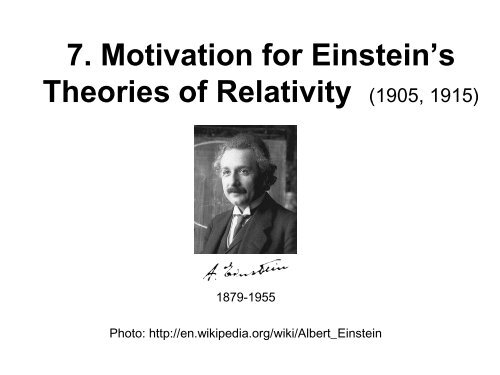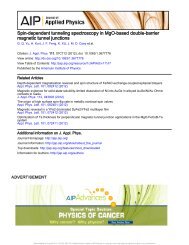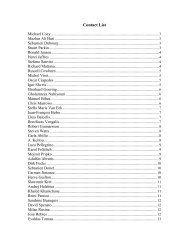7. Motivation for Einstein's Theories of Relativity (1905, 1915)
7. Motivation for Einstein's Theories of Relativity (1905, 1915)
7. Motivation for Einstein's Theories of Relativity (1905, 1915)
Create successful ePaper yourself
Turn your PDF publications into a flip-book with our unique Google optimized e-Paper software.
<strong>7.</strong> <strong>Motivation</strong> <strong>for</strong> Einstein’s<br />
<strong>Theories</strong> <strong>of</strong> <strong>Relativity</strong> (<strong>1905</strong>, <strong>1915</strong>)<br />
1879-1955<br />
Photo: http://en.wikipedia.org/wiki/Albert_Einstein
<strong>7.</strong>1 Unification <strong>of</strong> Electricity<br />
and Magnetism<br />
Brief history <strong>of</strong> findings<br />
•Greek philosophers: electric shocks, magnetic minerals<br />
•thought <strong>of</strong> as unrelated phenomena until 19 th century<br />
•Cavendish (1771,73), Coulomb (1785-91):<br />
q1q2<br />
<strong>for</strong>ce between two charges <strong>for</strong>ce ~ r<br />
(similar to Newton’s gravitational law)<br />
•Oersted (1819): electric current produces magnetic field<br />
•Ampère: <strong>for</strong>ces between two parallel currents, magnetic in nature<br />
•Faraday: magnetism produces electricity (induction); concept <strong>of</strong><br />
fields<br />
2
Maxwell (1873) summarises these results in<br />
four equations (here stated <strong>for</strong> vacuum)<br />
Coulomb’s law<br />
no magnetic monopole<br />
<br />
E<br />
<br />
B<br />
<br />
B<br />
<br />
E<br />
/ <br />
0<br />
0<br />
<br />
j <br />
0<br />
<br />
B<br />
<br />
t<br />
0<br />
<br />
0<br />
<br />
E<br />
t
• Maxwell showed that these equations can<br />
be reduced to wave equations <strong>for</strong> E and B<br />
<br />
2<br />
1<br />
E <br />
2<br />
c<br />
<br />
2<br />
E<br />
2<br />
t<br />
0;<br />
• The speed c <strong>of</strong> the wave is given by<br />
1<br />
c<br />
2<br />
<br />
ε 0 permittivity;<br />
μ 0 permeability (<strong>of</strong> free space)<br />
and is identified as the speed <strong>of</strong> light<br />
• Solutions <strong>of</strong> wave equations:<br />
<br />
E<br />
0<br />
<br />
<br />
0<br />
<br />
2<br />
1<br />
B <br />
2<br />
c<br />
<br />
2<br />
B<br />
2<br />
t<br />
<br />
ˆ ik( xct<br />
)<br />
; ˆ ik(<br />
xct<br />
)<br />
Ee B Be ;<br />
0;
Measurements <strong>of</strong> the speed <strong>of</strong> light<br />
• First attempts by Galilei (lanterns at mountain tops!)<br />
• Ole Roemer (1676): orbital period <strong>of</strong> Jupiter moon Io<br />
fluctuates with distance between Jupiter and earth<br />
(22 minutes)<br />
speed <strong>of</strong> light c ~ 2.14 ×10 8 m/s<br />
• Fizeau (1849), using spinning cogwheel:<br />
c ~ 3.133×10 8 m/s<br />
• Heinrich Hertz (1887) measure speed <strong>of</strong> light by<br />
sending and receiving radio waves<br />
• Today: c ~ 2.99792458×10 8 m/s = 299792.458 km/s
The question <strong>of</strong> the ether<br />
• Sound waves and water waves require a<br />
medium, what about light<br />
• Aristotle: “nature abhors a vacuum”<br />
• Descartes: light as an instantaneous<br />
disturbance in the ether (plenum)<br />
• Maxwell: “We can scarcely avoid the<br />
conclusion that light consists in the<br />
transverse undulations <strong>of</strong> the same<br />
medium which is the cause <strong>of</strong> electric and<br />
magnetic phenomena.”
But ether could not be found<br />
experimentally and was not<br />
required theoretically.<br />
• Michelson and Morley (1887): attempt to<br />
detect the passage <strong>of</strong> earth through the<br />
ether by measuring speed <strong>of</strong> light waves in<br />
different directions; no effect!<br />
• FitzGerald (1889), Lorentz (1892) object<br />
moving through ether would be contracted!
Michelson-Morley experiment<br />
observed interference fringes dependent upon optical path length<br />
if the earth travelled<br />
through an ether,<br />
there should be a<br />
time difference <strong>for</strong> the<br />
two different paths;<br />
thus a dependence<br />
in interference<br />
fringes on<br />
orientation<br />
No such detection–<br />
a null result.<br />
Young and Freedman, Figure 35.20
George Francis FitzGerald,<br />
1851-1901<br />
1881, TCD Erasmus Smith's Pr<strong>of</strong>essor <strong>of</strong> Natural and Experimental Philosophy<br />
1883, election to fellowship <strong>of</strong> the Royal Society (FRS)<br />
Flying a Lilienthal glider from the Pav!
“The Ether and the Earth's Atmosphere.”<br />
(Fitzgerald’s letter to Science Volume 13, Issue 328, pp. 390, 1889)<br />
I HAVE read with much interest Messrs. Michelson and Morley's wonderfully<br />
delicate experiment attempting to decide the important question as to how far<br />
the ether is carried along by the earth. Their result seems opposed to other<br />
experiments showing that the ether in the air can be carried along only to an<br />
inappreciable extent. I would suggest that almost the only hypothesis that<br />
can reconcile this opposition is that the length <strong>of</strong> material bodies<br />
changes, according as they are moving through the ether or across it, by<br />
an amount depending on the square <strong>of</strong> the ratio <strong>of</strong> their velocity to that <strong>of</strong><br />
light. We know that electric <strong>for</strong>ces are affected by the motion <strong>of</strong> the electrified<br />
bodies relative to the ether, and it seems a not improbable supposition that the<br />
molecular <strong>for</strong>ces are affected by the motion, and that the size <strong>of</strong> a body alters<br />
consequently. ...<br />
Dublin, May 2<br />
fitzgerald_science_13_390_89.pdf
<strong>7.</strong>2 <strong>Motivation</strong> <strong>of</strong> Einstein’s<br />
theory <strong>of</strong> special relativity<br />
• Galilean trans<strong>for</strong>mation<br />
(Young and Freedman, Figure 3<strong>7.</strong>02)
• Galilei trans<strong>for</strong>mation in principle valid <strong>for</strong><br />
all velocities V <strong>of</strong> moving frame <strong>of</strong><br />
reference, but what happens to Maxwell’s<br />
equations at V=c Time dependence<br />
drops out!<br />
<br />
E<br />
<br />
ˆ<br />
ik<br />
Ee<br />
( x(<br />
cV<br />
) t)<br />
• But if E doesn’t change, also B doesn’t,<br />
electromagnetic theory would collapse!<br />
→ Einstein decides to reinvestigate<br />
Galilean trans<strong>for</strong>mation
<strong>1905</strong>: Two Postulates<br />
1. all physical laws valid in one frame <strong>of</strong><br />
reference are equally valid in any other<br />
frame <strong>of</strong> reference moving uni<strong>for</strong>mly<br />
relative to the first (inertial frame)<br />
2. speed <strong>of</strong> light in vacuum is the same in all<br />
inertial frames, regardless <strong>of</strong> motion <strong>of</strong><br />
light source<br />
Thus there is no frame at which c=0, no<br />
frozen electromagnetic wave.
Startling Consequences<br />
• Space and time are relative<br />
Change in space and time must make up<br />
<strong>for</strong> motion <strong>of</strong> light source in frame where<br />
source is moving<br />
• <strong>Relativity</strong> <strong>of</strong> simultaneity<br />
• Time dilation<br />
• Length contraction<br />
(details in your<br />
lectures on<br />
special relativity:<br />
PY1T10, PY2P20)<br />
• E=mc 2 as consequence <strong>of</strong> the new Lorentz<br />
trans<strong>for</strong>mation (replacing Galileian trans<strong>for</strong>mation)
All these predictions have been<br />
confirmed by experiments.<br />
Examples:<br />
• E=mc 2 ; Cockr<strong>of</strong>t and Walton<br />
• decay <strong>of</strong> high speed cosmic ray produced<br />
muons 10 times slower than if they were at rest<br />
to observer
<strong>7.</strong>3 <strong>Motivation</strong> <strong>for</strong> Einstein’s<br />
general theory <strong>of</strong> relativity<br />
• Newton’s Law <strong>of</strong> Gravity<br />
F G<br />
m m<br />
1<br />
r<br />
2<br />
2<br />
G: gravitational constant<br />
• Instantaneous <strong>for</strong>ce: action at a distance<br />
• But how is this <strong>for</strong>ce transmitted<br />
• Also: strictly speaking two definitions <strong>of</strong><br />
mass; inertial mass (Newton’s second<br />
law, F= m inertial a and gravitational mass,<br />
but experiments show they are the same
Consider reference frames that are<br />
accelerated<br />
(Young and Freedman, Figure 3<strong>7.</strong>24)<br />
Astronaut about to drop<br />
watch in space-ship.<br />
Absence <strong>of</strong> gravity in<br />
space. Watch hits floor<br />
due to acceleration <strong>of</strong><br />
rocket.<br />
On earth watch hits<br />
floor due to gravity.<br />
Impossible <strong>for</strong> astronaut to distinguish whether in<br />
gravitational field or accelerating rocket.
Einstein needed to use more complicated tensor calculus to<br />
express this mathematically as well as a new flexible coordinate<br />
frame or geometry<br />
Einstein’s field equation <strong>for</strong> General <strong>Relativity</strong> is <strong>of</strong>ten written as:<br />
G<br />
<br />
8<br />
G<br />
T<br />
4<br />
c<br />
Space time curvature tensor expressed as G μν - related to the<br />
stress-energy tensor T μν , which is related to the distribution <strong>of</strong><br />
mass in spacetime.
• Space is distorted by gravitational fields (stars, black<br />
holes),<br />
• Or: space is no longer absolute, but defined by matter<br />
(Young and Freedman, Figure 3<strong>7.</strong>25)
Again:<br />
Predictions <strong>of</strong> theory <strong>of</strong><br />
general relativity have<br />
been experimentally<br />
confirmed.
Bending <strong>of</strong> light<br />
• Beam <strong>of</strong> light emitted perpendicular to direction <strong>of</strong><br />
acceleration does not travel in straight line, but also<br />
“falls” – Newton’s gravitation also predicts this, but<br />
Einstein’s theory differs in the magnitude <strong>of</strong> effect –<br />
predicts it to be double.<br />
• Measurable effect in agreement with Einstein’s theory<br />
- e.g Eddington’s measurement <strong>of</strong> 1919 – repeated<br />
measurements with a definitive measurement in 1960<br />
using radio waves
Explanation <strong>of</strong> anomalous precession <strong>of</strong> the<br />
perihelion <strong>of</strong> mercury<br />
• Perihelion: point in orbit nearest to the sun (furthest<br />
point: aphelion)<br />
• Precession: orbit not fully closed<br />
• Only partly explained by classical physics (influence<br />
<strong>of</strong> other planets)<br />
Gravitational redshift – photons lose energy in<br />
escaping a gravitational potential well
As time goes by (Herman Hupfeld 1931, Casablanca 1942)<br />
This day and age we're living in<br />
Gives cause <strong>for</strong> apprehension<br />
With speed and new invention<br />
And things like fourth dimension.<br />
Yet we get a trifle weary<br />
With Mr. <strong>Einstein's</strong> theory.<br />
So we must get down to earth at times<br />
Relax relieve the tension<br />
And no matter what the progress<br />
Or what may yet be proved<br />
The simple facts <strong>of</strong> life are such<br />
They cannot be removed.<br />
You must remember this<br />
A kiss is just a kiss, a sigh is just a sigh.<br />
The fundamental things apply<br />
As time goes by.
Desolation Row, Bob Dylan 1965<br />
Einstein, disguised as Robin Hood<br />
With his memories in a trunk<br />
Passed this way an hour ago<br />
With his friend, a jealous monk<br />
He looked so immaculately frightful<br />
As he bummed a cigarette<br />
Then he went <strong>of</strong>f sniffing drainpipes<br />
And reciting the alphabet<br />
Now you would not think to look at him<br />
But he was famous long ago<br />
For playing the electric violin<br />
On Desolation Row




